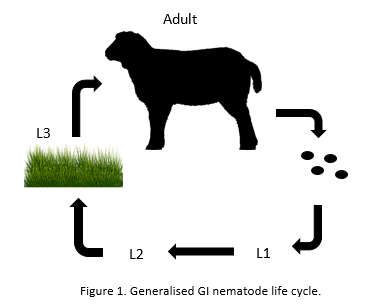Dr Elizabeth Hart: IBERS, Aberystwyth University.
Take home messages:
- The application of alternative measures to reduce the reliance on anthelmintics to treat parasites in livestock are an important issue.
- The rate of larval migration upon pastures largely depends on the parasitic species present.
- Rotational grazing offers an evasive strategy to control worm burden within livestock, however the length of grazing period and rest period for pastures need to be carefully considered.
Gastrointestinal nematodes (GIN) pose huge problems to farmers in terms of production and economic losses. Anthelmintics are heavily relied upon to treat parasites, however anthelmintic resistance is a growing concern. For example, resistance to the Benzimidazoles (white group of anthelmintic) is now very common across the UK, and resistance to the levamisoles (yellow group) and the macrocyclic lactones (clear group) are also increasing. Therefore, treatment practice and grazing management is a highly important issue as once resistance is established it cannot be reversed. The life cycle of most gastrointestinal (GI) nematodes of grazing livestock result in worm eggs passed out onto the pasture within animal faeces, which then develop into first stage (L1) and then second stage (L2) larvae. They then develop into the third stage (L3) larvae or the infective stage where they migrate into the surrounding vegetation and are consumed by the grazing animal. Larval development continues in the digestive tract of the animal where the parasites mature into adults (Fig 1.). However, there are variations within the life cycle dependent on the parasitic species.
The development of GI nematodes throughout their life cycle is largely affected by the climatic conditions. For instance, the migration of L3 larvae through pasture is generally enhanced by wetter and warmer conditions. However, the extent at which larval migration takes place depends on the species, for example Teledorsagia circumcincta have been shown to remain in faecal matter for longer periods compared to Haemonchus contortus and optimal climate conditions for larvae development vary between species. H. contortus has shown to survive better in warmer, moist weather with poor survival in cool or warm dry weather and sub-freezing winters; T. columbriformis survives optimally in cool or warm moist weather with poor survival over sub-freezing winters and T.circumcincta demonstrates optimum survival in cool, moist weather and sub-freezing winters, with poor survival in warm, dry weather.
Rotational grazing
Rotational grazing offers an evasive strategy for controlling worm numbers within livestock. By dividing pasture into subplots of land, animals can be grazed after the infective larvae have died off. This is achieved by breaking the parasitic life cycle (Fig 1) and moving animals to new pasture before eggs can develop into L3. However, climatic conditions as mentioned above have a significant effect on the rate of larval die off, so identifying which parasitic species is present on farm will enable a better estimation of the required resting period for the field. Previous research has shown that rotational grazing methods can aid in GIN management. For example, work by Eysker et al., (1998) showed that moving animals at monthly intervals to clean pasture can aid in the immunity development of animals as well as a means of parasitic control. Research conducted by Colvin et al., (2008) demonstrated that rotational grazing systems with short grazing periods and long rest periods can assist with GIN control in cool temperate climates, where it was shown that grazing for 5 days and resting pasture for 103 days resulted in lower faecal egg counts, particularly in regard to H. contortus infection. A study conducted by Burke et al., (2009) investigated the effects of rotational grazing compared to continuous grazing on year old lambs for GIN control. The results showed that weight gains between rotational and continuously grazed lambs were similar, but deworming was required to a greater extent with the continuously grazed lambs. However, the authors concluded that further investigation is required on rotational grazing systems with higher forage quality. Rotational grazing can also be undertaken by alternating between types of stock. For example, studies have reported much lower levels of parasite burden in livestock where sheep and cattle were alternately grazed. However, not all studies have demonstrated long term success.
Production requirements within rotational grazing systems also need to be carefully considered. Therefore, the estimation of grazing and rest periods for paddocks needs to be determined. Since all the available pasture in rotational grazing systems may be extensively grazed, this stimulates sward growth and can lead to increased productivity of the pasture. However, timing is critical, as enough rest time needs to be given for necessary pasture regrowth and larvae die off without compromising sward quality. Hence, research suggests that rotational grazing may be more effective in tropical climates, as a shorter length of time would be required to rest the pasture due to the reduced survival rate of the migrating larvae (3-7 weeks) compared to more temperate regions (up to 3 to 9 months depending on species and conditions). In addition, pasture composition can also affect the movement of infective larvae and the use of alternative forages can offer further means of parasite control. For example, chicory has been reported to lower faecal egg counts in lambs and improve weight gains and legumes such as red clover, have been shown to affect larval migration, thereby lowering infection rates.
Summary
Although rotational grazing holds potential to reduce worm burden on pasture, it requires much thought regarding grazing management. Farmers would need to consider the length of time given to grazing and rest periods, stocking density, type of stock and forage type in order to consider rotational grazing as a further means of GIN control. At present for more temperate regions it would seem beneficial to focus on a combination of optimal grazing management strategies, such as forage type, alternating stock and the monitoring faecal egg counts on pasture, rather than relying solely on rotational grazing to reduce the risk of potential GIN infection.


